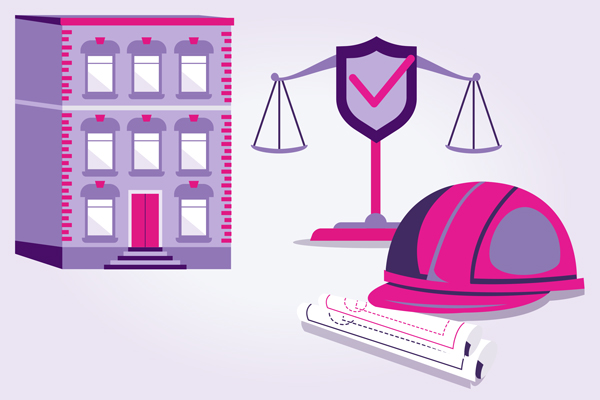
According to the government, many of the measures included within the 252-page bill are likely to take between a year and 18 months to introduce.
But what does the Building Safety Act entail and what impact could it have on surveyors and building surveys?
How will the Act change construction forever?
More than anything else, the tragic Grenfell Tower fire in June 2017 brought into sharp focus the absolute need for buildings to be safe, as well as generating a nationwide debate about cladding.
Since the Grenfell fire, Government and stakeholders have been working on ways to ensure nothing like it ever happens again.
The Building Safety Act will implement major changes to the regulation of building safety of residential and mixed-use buildings.
In a blog post after the Act received Royal Assent, the team at law firm Bryan Cave Leighton Paisner said: “The changes will be far-reaching and the Act (even before receiving Royal Assent) has already been a catalyst for change. For example, the changes introduced by the Act will not only affect the way future residential buildings will be procured, constructed, and occupied but also will alter the landscape for remediation claims and cost recovery.”
The Act is roughly broken down into six parts and 11 schedules.
Major goals set out by the acts early parts are those of improving the overall standard of buildings, improving the building regulations approval process and defining the role of the new Building Safety Regulator (someone appointed to oversee the safety of a building).
The act also then covers the ‘duties and obligations’ of maintaining higher risk structures and includes changes to Defective Premises Act 1972 and the Landlord and Tenant Act 1985 (s20 and new s20D provisions).
Additionally, it introduces new home warranties, the New Homes Ombudsman Scheme that will help homebuyers make complaints against developers and details remedies for defective construction products, as well as changes to some fire safety laws.
Not all parts of the Act have come into force immediately – some will be within two months of Royal Assent and others will be at a time that hasn’t yet been decided.
Experts say the Act is technical and complex, and more detail in secondary legislation will be coming further down the line. They also say that the new Act isn’t in isolation, with other things driving change in building safety and potentially more to come after the completion of the ongoing Grenfell Inquiry.
How will surveyors and building surveys be affected?
The Royal Institution of Chartered Surveyors (RICS), the industry’s leading trade body, says the Building Safety Act is the ‘most complex piece of legislation since World War II’ and will have an impact on RICS members and firms in England.
Describing it as the ‘next step in post-Grenfell reforms’, and designed to give residents and homeowners more ‘rights, powers and protections’, the body says the act will overhaul regulations and set out a clear pathway on how buildings should be constructed, maintained and made safe.
Improving compliance is a major facet of the Act, RICS adds, with a new framework for tougher penalties to be levied on those who ignore the rules.
It says RICS members working on high-risk buildings will need to show a higher level of competence, with third party oversight of any new accreditation.
This, the body says, will affect a number of pathways, especially building control, where the new Building Safety Regulator (within the HSE) will have oversight of all professionals and firms, but not local authorities. The organisation says the change will also impact building surveyors as well as designers, block managers, quantity surveyors and property managers.
RICS set out its thoughts on the Building Safety Act here. They said: “Firstly, while we know that there is set to be secondary legislation and guidance, getting the details of this right will be essential for industry and firms across the country to effectively implement the changes required.”
It added: “The industry will need a clear brief from Government on the timeline moving forward, when the legislation will be ready, and any consultations that will be brought in to allow industry to support at pace. It is critical for RICS and other organisations representing the professions impacted by the Act, to have the opportunity to offer their continued support in finding and shaping the solutions alongside Government.”
Building surveys themselves are likely to look very different, too, especially for high-rise buildings, with new standards for all types of surveyors.
This Gov.uk page sets out the goals of the Act, what it means for residents and homeowners, what it means for building owners, and what it means for the built environment industry as a whole.
With secondary legislation still to follow, and the Act already being regarded as some of the most complex legislation since the 1940s, it is likely to take some time for the industry to digest – but one thing seems clear; the way homes and buildings are constructed will be altered forever.